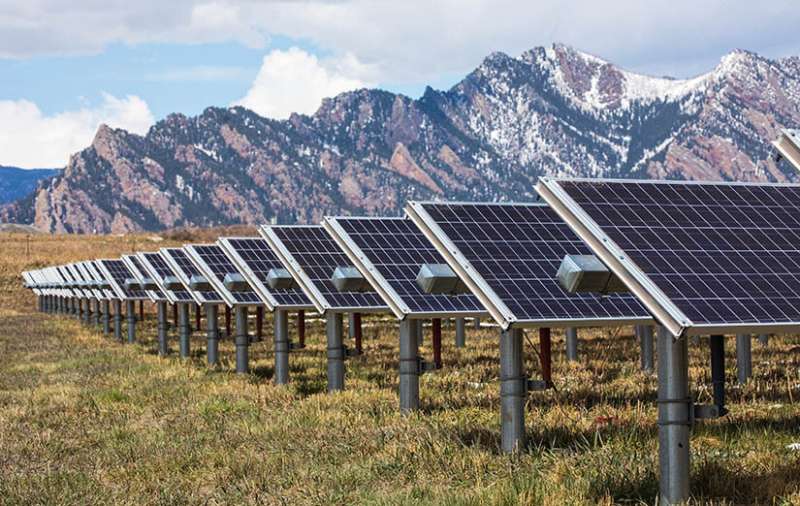Researchers have determined that moving solar arrays farther apart from each other can have benefits both in economics and efficiency. Credit: Werner Slocum, NREL
Moving rows of solar panels farther apart can increase efficiency and improve economics in certain instances by allowing greater airflow to whisk away some heat, according to a new analysis.
Solar panels work by capturing sunlight and converting that to electricity, but the accompanying heat can decrease their power output slightly. The analysis looked beyond current operating assumptions that considered only the amount of sunlight, wind speed, and ambient temperature.
"But in reality, when you look at the layout of the system, like how the modules are spaced apart, what angle they're at, how high they're off the ground—that all affects airflow," said Matthew Prilliman, a researcher at the National Renewable Energy Laboratory (NREL) whose expertise includes modeling the performance of photovoltaic (PV) systems.
Prilliman is lead author of the paper "Technoeconomic Analysis of Changing PV Array Convective Cooling Through Changing Array Spacing," which appears in the IEEE Journal of Photovoltaics. Other co-authors from NREL are Janine Keith and Tim Silverman. Outside NREL, the co-authors are Sarah Smith and Raúl Bayoán Cal from Portland State University and Marc Calaf and Brooke Stanislawski from the University of Utah, Salt Lake City. (Stanislawski is now with NREL.)
The temperature of a PV module is second only to the amount of sunlight it receives in terms of impact on module electrical output. The maximum power output of a module drops by 0.3% to 0.5% per degree increase in module temperature. Sunlight is the primary driver of the module temperature, with the wind speed having a secondary effect.
The analysis, which relied on NREL's System Advisor Model, demonstrated that a greater separation between rows would improve the performance of a PV system by allowing airflow to cool down the solar modules. Prilliman said few previously used computer models considered the changes in heat transfer caused by differences in how an array is configured.
"This is relatively unexplored territory," he said.
The research could be particularly relevant for the growing field of agrivoltaics, in which crops are planted adjacent to or below solar panels. The changing land usage for different layouts would affect the placement of crops, which could in turn also affect wind flow.
"Increasing spacing could enable more varieties of crops and more types of agricultural equipment to be utilized in agrivoltaic systems," said Jordan Macknick, who leads a different NREL research project focused on agrivoltaics. "That could potentially make these spaced-out solar systems more cost-effective and compatible with larger-scale agriculture."
By distancing the panels further, the amount of ground-reflected irradiance on a solar module increases and the incidence of modules casting shade on each other decreases. The increased spacing also allows greater wind flow, which can result in lower module temperatures and higher energy output.
The researchers did not specify how far apart the panels should be because each PV system is different and depends upon local conditions. They did point out the greatest improvements came in climates with low average annual ambient temperatures and moderate to high average annual wind speeds.
A greater separation of rows carries additional costs, the researchers found. Notably, more land is needed as the arrays are spaced out more. In addition, wiring costs increase as the arrays are more spread out. Crucially, the researchers determined the benefits outweigh the costs in many cases.
More information: Matthew Prilliman et al, Technoeconomic Analysis of Changing PV Array Convective Cooling Through Changing Array Spacing, IEEE Journal of Photovoltaics (2022). DOI: 10.1109/JPHOTOV.2022.3201464
Provided by National Renewable Energy Laboratory























